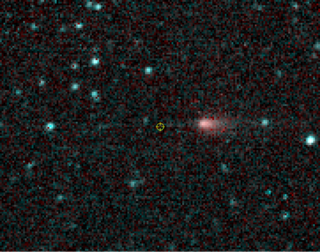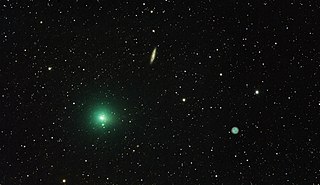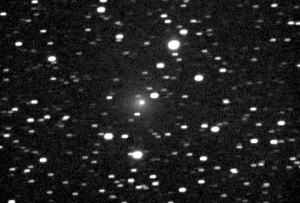
57P/du Toit–Neujmin–Delporte is the designation of a periodic comet. It is a member of the Jupiter family of comets whose orbits and evolution are strongly influenced by the giant planet. In 2002 it was discovered to have broken up into at least 20 fragments. At the time of their discovery, these shed fragments were spread out along the orbital path subtending an angle of 27 arcminutes from the comet's surviving head.

10P/Tempel, also known as Tempel 2, is a periodic Jupiter-family comet with a 5 year orbital period. It was discovered on July 4, 1873 by Wilhelm Tempel. The next perihelion passage is 2 August 2026 when the comet will have a solar elongation of 164 degrees at approximately apparent magnitude 8. Closest approach to Earth will be one day later on 3 August 2026 at a distance of 0.414 AU (61.9 million km).

41P/Tuttle–Giacobini–Kresák is a periodic comet in the Solar System. The comet nucleus is estimated to be 1.4 kilometers in diameter.

52P/Harrington–Abell is a periodic comet in the Solar System.

60P/Tsuchinshan, also known as Tsuchinshan 2, is a periodic comet in the Solar System with an orbital period of 6.79 years. Tsuchinshan is the Wade-Giles transliteration corresponding to the pinyin Zĭjīn Shān, which is Mandarin Chinese for "Purple Mountain".

77P/Longmore is a periodic comet in the Solar System, with a period of 6.8 years.

7P/Pons–Winnecke is a periodic Jupiter-family comet with a six-year orbit. Early calculations for the 1921 apparition suggested that the orbit of the comet might collide with Earth in June, but observations on 10 April ruled out an impact. It made a very close approach to Earth in June 1927. The outward migration of perihelion created impressive meteor showers in 1916, 1921 and 1927.

13P/Olbers is a periodic comet with an orbital period of 69 years. It fits the classical definition of a Halley-type comet with. The comet had last been seen in 1956 and the next perihelion is on 30 June 2024.

Comet Finlay is a periodic comet with an orbital period of 6 years discovered by William Henry Finlay on September 26, 1886. The next perihelion passage is July 13, 2021 when the comet will have a solar elongation of 54 degrees at approximately apparent magnitude 10. It last came to perihelion on December 27, 2014, at around magnitude 10. Of the numbered periodic comets, the orbit of 15P/Finlay has one of the smallest minimum orbit intersection distances with the orbit of Earth (E-MOID). In October 2060 the comet will pass about 5 million km from Earth.
178P/Hug–Bell is a periodic comet in the Solar System. It was discovered by Northeast Kansas Amateur Astronomers' League members Gary Hug and Graham Bell and is thought to be the first periodic comet to be discovered by amateurs. It was declared a comet less than two days after its initial discovery, after having its course confirmed on previous images.

Comet Kopff or 22P/Kopff is a periodic comet in the Solar System. Discovered on August 23, 1906, it was named after August Kopff who discovered the comet. The comet was missed on its November 1912 return, but was recovered on its June 1919 return and has been seen at every apparition since. Close approaches to Jupiter in 1938 and 1943 decreased the perihelion distance and orbital period. 22P/Kopff’s last perihelion passage was 18 March 2022. On 13 July 2028 it will pass 0.353 AU (52.8 million km) from Earth.

23P/Brorsen–Metcalf is a periodic comet with an orbital period of 70 years. It fits the classical definition of a Halley-type comet with. It was first discovered by Theodor Brorsen at the Altona Observatory on July 20, 1847, and again by Kaspar Schweizer (Moscow) on August 11, 1847. It was predicted that it would reappear between 1919 and 1922.

Comet Schaumasse is a periodic comet discovered by Alexandre Schaumasse on 1 December 1911 as 12th magnitude. It next comes to perihelion on 8 January 2026 and should brighten to about magnitude 9.

68P/Klemola or Klemola's Comet is a periodic comet, which belongs to Jupiter's comet family, that was discovered in 1965 by American astronomer Arnold Richard Klemola in Argentinian Yale-Columbia Southern Station. Its orbital period is 10.82 years.
82P/Gehrels is a periodic comet that was discovered on October 27, 1975, by Tom Gehrels at the Palomar Mountain Observatory in California having a faint nuclear brightness of magnitude 17.

62P/Tsuchinshan, also known as Tsuchinshan 1, is a periodic comet discovered on 1965 January 1 at Purple Mountain Observatory, Nanking. It will next come to perihelion on 25 December 2023 at around apparent magnitude 8, and will be 0.53 AU (79 million km) from Earth and 110 degrees from the Sun.
51P/Harrington is a periodic comet in the Solar System.
72P/Denning–Fujikawa is a periodic comet discovered on 4 October 1881 by William Frederick Denning. The comet was not seen at another apparition until recovered by Shigehisa Fujikawa in 1978. From 29 December 1978 until 17 June 2014, the comet was lost. On 17 June 2014 the comet was recovered by Hidetaka Sato at apparent magnitude 16 when it was 50 degrees from the Sun. The comet came to perihelion in June 2023, and will next come to perihelion in May 2032.

58P/Jackson–Neujmin is a periodic comet in the Solar System with a current orbital period of 8.19 years.
79P/du Toit–Hartley or du Toit 2 is a periodic comet, now divided into two parts, in the Solar System with an orbital period of 5.06 years. It next comes to perihelion in September 2023 but is only expected to reach about apparent magnitude 18. It will be less than 90 degrees from the Sun from February 2023 until June 2024. On 26 May 2024 it will be 2.7 AU from the Sun and Earth.

















